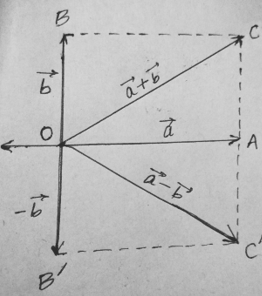Establish the following vector inequalities geometrically or otherwise:
A. ![]()
B. ![]()
D. ![]()
When does the equality sign above apply?
Let us consider two vectors ![]() and
and ![]() such that
such that ![]() =
=![]() and
and ![]() =
=![]() . Also,
. Also,![]() =
=![]() . According to Parallelogram law of vector addition,
. According to Parallelogram law of vector addition, ![]() =
=![]() and
and ![]() =
=![]() as shown in the figure.
as shown in the figure.

From the figure,
OA=![]()
OB=AC=![]()
OC=![]()
OC’=![]()
A. In a triangle, each side is smaller than the sum of other two sides.
So, in ΔAOC,
OC < OA + AC
⇒ ![]()
If both the vectors act along a straight line, then the equality condition occurs as
So, ![]() =
=![]()
∴ ![]()
B. In ΔAOC,
OC+AC>OA
⇒ |OC|>|OA-AC|
⇒ |OC|>|OA-OB| (∵ AC=OB are the parallel sides of the parallelogram)
⇒ ![]()
If both the vectors act along a straight line, then the equality condition occurs as
![]()
∴ ![]()
C. In ΔOAC’,
OC’<OA+AC’
⇒ ![]()
⇒ ![]() (∵
(∵ ![]() )
)
If both the vectors act along a straight line, then the equality condition occurs as
![]()
∴ ![]()
D. In ΔOAC’,
OC’+AC’>OA
⇒ |OC’|>|OA-AC’|
⇒ ![]()
⇒ ![]()
If both the vectors act along a straight line, then the equality condition occurs as
![]()
∴ ⇒ ![]()
NOTE: Parallelogram Law of Vector Addition states that when two vectors are represented by two adjacent sides of a parallelogram by direction and magnitude then the resultant of these vectors is represented in magnitude and direction by the diagonal of the parallelogram starting from the same point.